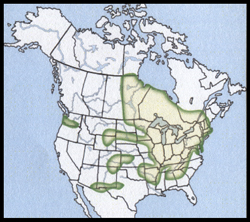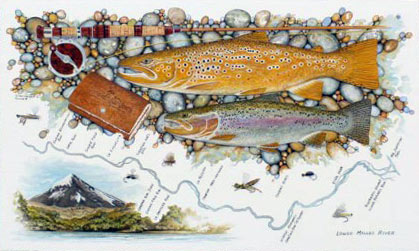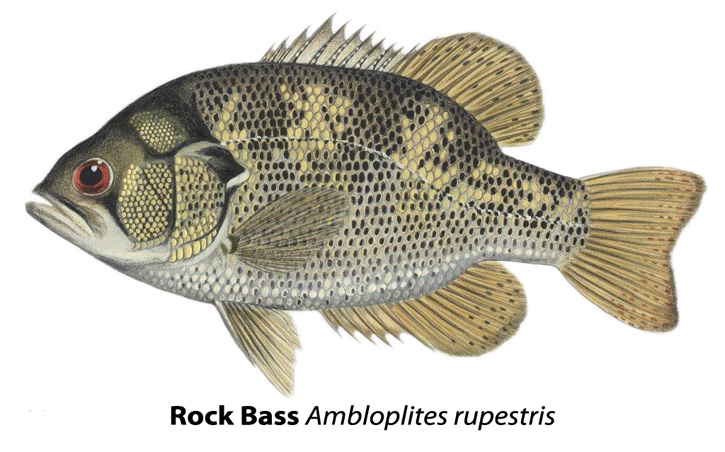Rock Bass, May 2014, Fish of the Month!
A Brief Note to Our Readers:
The Rock Bass is the first in our list of members of the Sunfish family.
Rock Bass
Ambloplites rupestris
Local Names:
Goggle-eye, Red-eye, Red eye bass Northern Rock bass
Average Size:
6 to 10 inches
Distinguishing Field Marks:
(See the illustration.)
-
The head is large, as is the eye.
-
The base color of the eye is red.
-
The mouth is large with the upper jaw extending to the mid-point of the eye.
The two dorsal fins are attached. The first dorsal has 10, 11, or 12 stiff spines, the second has one spine.
The anal fin has 5, 6, or 7 spines on and following its leading edge.
North American Range:
Map to the right shows approximate range in North America.
Diet:
Throughout its life the Rock bass feeds heavily on aquatic invertebrates, especially insects, adults also take crayfish and small fishes in some quantity.
Biology:
The nesting and spawning behavior of this species is typical of the other members of the Sunfish family, and so is included in this entry.
At a water temperature ranging from 60 to 70 degrees F. Rock bass begin nesting. The male of the species selects a site and makes a shallow depression in the substrate. Although usually much smaller, these nests may be as much as 2 feet in diameter. They are typically sited in close proximity to one another on prime annual spawning grounds. They are very jealously guarded by their male excavators who exhibit aggressive pre and post spawning behavior toward their neighbors. Nests may be constructed in habitats ranging from fine gravel or sand bottoms to heavily vegetated swampy areas. When females begin to move out of their deeper wintering waters to join the males in the shallows, individual males rush out to their preferred mates, swim in circles around and over them, and then lead them back to the nest sites where the two mill about close to one another until the female is ready to commence spawning and signals this by gradually turning onto one side with the male remaining in an upright position head to tail with the female. The pair vibrates and rocks back and forth as the eggs and sperm clouds are released and fertilized in small batches over a period of about an hour. The typical female Rock bass will carry from 3,000 to as many as 11,000 eggs. Females are likely to spawn with multiple males and release eggs into a nest where another female has already mated with the male of that nest, another way that “nature” assures successful reproduction of especially these small species.
The fertilized eggs are adhesive, are fanned by the male throughout their incubation, and also protected by him after they have hatched. The female leaves the nest site immediately after she has completed spawning and begins feeding. The incubation period is short, about 3 to 4 days at a temperature of 69 degrees F. (20.56 degrees C.).
The young grow quite rapidly, attaining a length of about 2 inches (5.08 cm.) by their first fall.
Fly Fishing for Rock Bass:
Within their range Rock bass are found in a wide assortment of habitats, but are especially fond of those including large rocks. They inhabit the lower portions of small streams and the shallow rocky margins of rivers and lakes.
Few adult anglers actively pursue Rock bass, but probably everyone fishing within their range will hook them from time to time. They are aggressive, hit hard, and put up a very strong fight, especially for their size. This is another of our small native fish species that can provide young sportsmen plenty of fun and an opportunity to become better anglers. Outfits in the 4/5 weight range will allow these feisty sunfish to make good accounts of themselves once hooked. They variety of flies that they’ll readily take covers the full range of possibilities. Small fly-rod poppers will provide plenty of fun as a Rock bass makes a surface take.
As is the case with all our smaller sunfish species, the majority of Rock bass are taken only as incidentals by anglers seeking larger fish, especially Smallmouth bass. We’re assuming that this article won’t inspire many long distance Rock bass focused fishing trips.
Although they are typically of a small size, like their relatives, Rock bass make an excellent meal for those willing to properly prepare them. Their meat is white, firm, and of an mildly sweet flavor, which is one reason why all these small fresh-water fish species are called “pan-fish.”
Significance to Humans:
For generations, within their central states range, Rock bass have been commercially fished, especially in Lakes Erie and Ontario, and are there locally marketed as fresh fish. This species’ role as a game fish is primarily that of a “kids’” fish.
Like all our smaller sunfishes, this hardy species can be successfully kept in a large home aquarium. These fish will thrive when fed live native foods collected by the aquarist. Keeping Rock bass, or any native species, in a home aquarium is an excellent way to encourage our young folks to a first-hand investigative look into how the natural world works.
Status:
Thriving.







